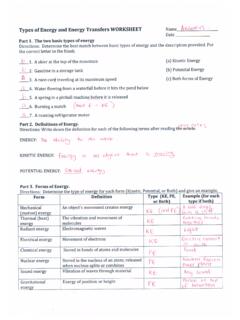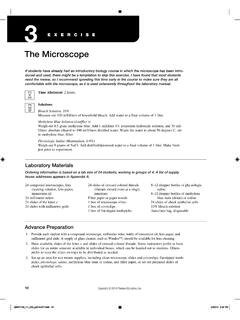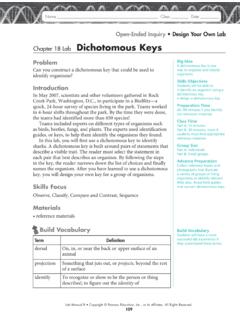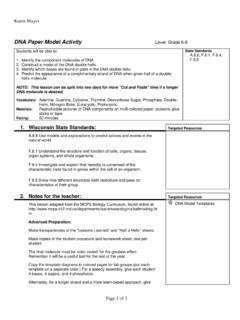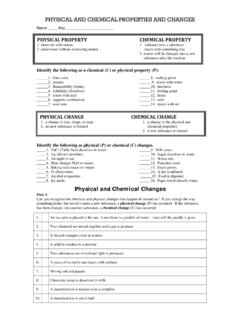Transcription of Physics Lab: Measuring the acceleration due to gravity ...
1 Physics Lab: Measuring the acceleration due to gravity . Objective: to determine the acceleration due to gravity near the earth's surface by three different methods. Theory: We all know that gravity makes things fall. But just what is gravity ? Sir Isaac Newton tried to give operational meaning to the idea of gravity by seeking out the laws according to which it acts. Bodies near the earth fall toward it with a certain acceleration due to the gravitational attraction of the earth. How can the earth make a body at a distance fall toward it? How is the gravitational force transmitted? Has the acceleration due to gravity always stayed the same? These and many other questions about gravity have yet to be answered satisfactorily. In doing this lab, you will become more familiar with the effects of gravity by finding the acceleration due to gravity experimentally.
2 The standard value will be m/sec2. Method A: Measuring g from a free-fall apparatus The acceleration due to gravity (g) can be most easily measured by the use the of the basic motion equations. An object is dropped from a known height, the time is measured, and the equation d = v i t + a t2. is used to calculate the acceleration due to gravity g. Procedure: 1) Place the small diameter ball in the apparatus at a height approximately .7 meters above the landing pad. Measure the actual distance from the bottom of the ball to the pad and record. 2) Release the ball and record the drop time. Repeat 2 more times and calculate/record the average for that ball and height. 3) Repeat the procedure at the same height with the large diameter ball, making sure to reset the timer after each drop.
3 4) Repeat procedures 1-3 at heights approximately meters and meters, recording the actual measured heights and drop times in the appropriate locations. 5) Calculate g for each height and each ball, for a total of 6 values. Record on the results table. 6) Calculate an average g value from the six values, and calculate the percent discrepancy for this method from this average. Record this average g and its percent discrepancy in the separate results table. Method B: Measuring g by hand timing an object in free-fall The acceleration due to gravity can also be measured by timing a free fall with a stop watch. The method of determining the time is a bit different the method A, but the equation used is the same. Procedure: 1) Hold a small ball about .75m above the floor.
4 Measure and record this height. Drop the ball, timing the fall with a stopwatch. Be sure to have one person drop and another time the fall. Repeat 2 more times and calculate/record the average time in the table. 2) Repeat at the same height with the large ball. Record the average time in the table. 3) Repeat procedures 1-2 with both balls at two additional heights, approximately and meters above the floor. Record the heights and average times. 4) Calculate g for each height and each ball, for a total of 6 values. Record on the results table. 5) Calculate an average g value from the six values, and calculate the percent discrepancy for this method from this average. Record this average g and its percent discrepancy in the separate results table. DATA SHEET. Method A: Height Small ball Large ball Small ball g Large ball g time time value value Average g value: _____.
5 Percent Discrepancy: _____. Method B: Height Small ball Large ball Small ball g Large ball g time time value value Average g value: _____. Percent Discrepancy: _____. Summary Table Method g value Percent discrepancy A: free fall apparatus B: free fall hand timing Questions: 1) Based on your data, which method gave the best results? Was this what you expected? 2) Based on your data, which method gave the worst results? Was this what you expected? 3) Why are the times and g values in method A and B averag


